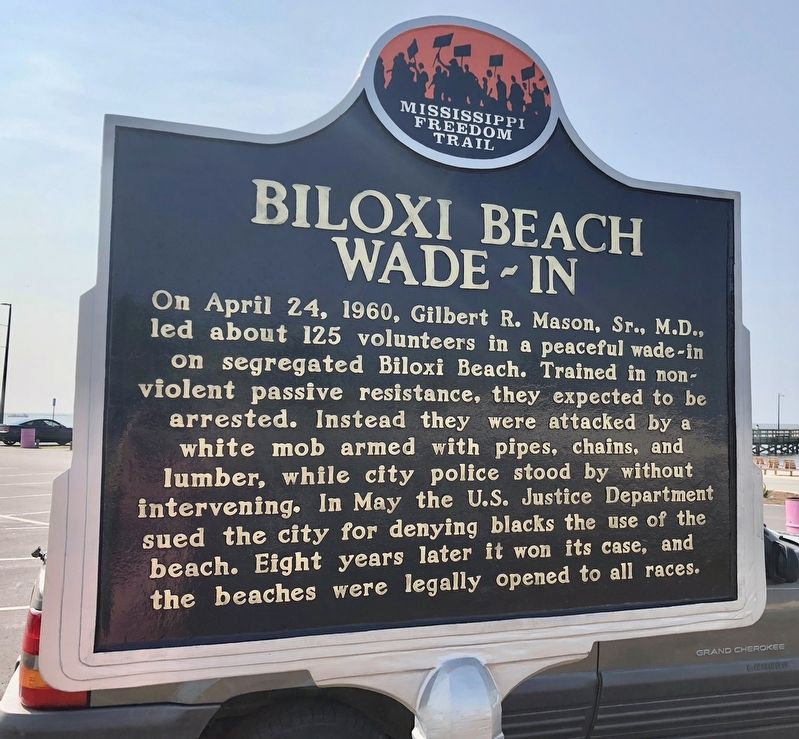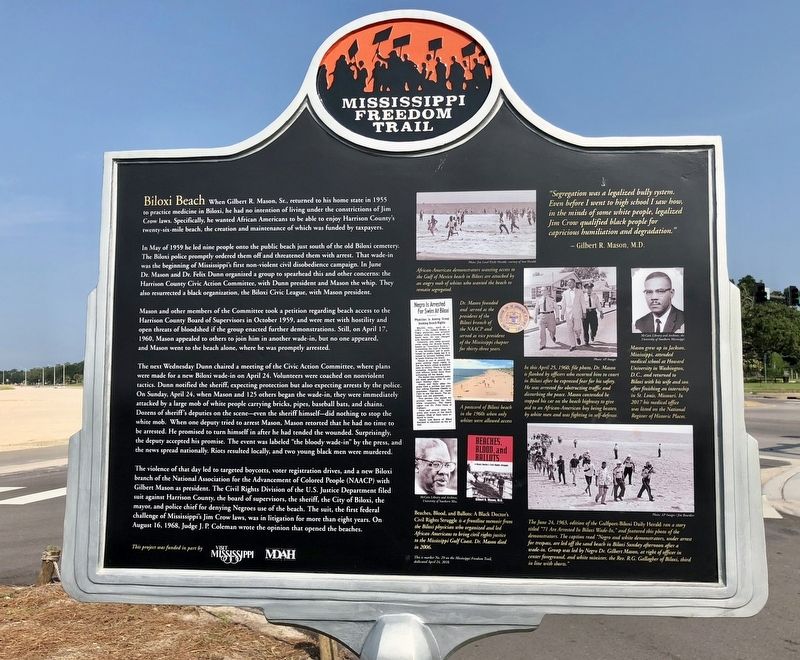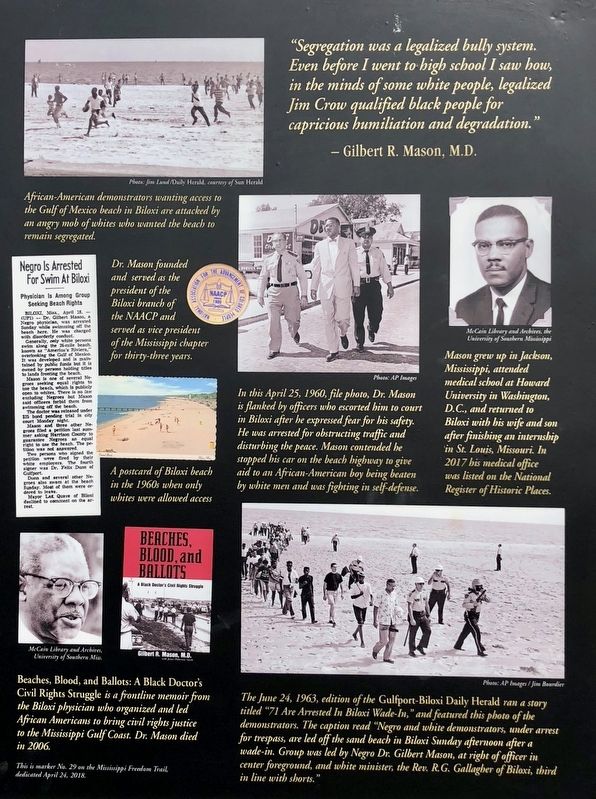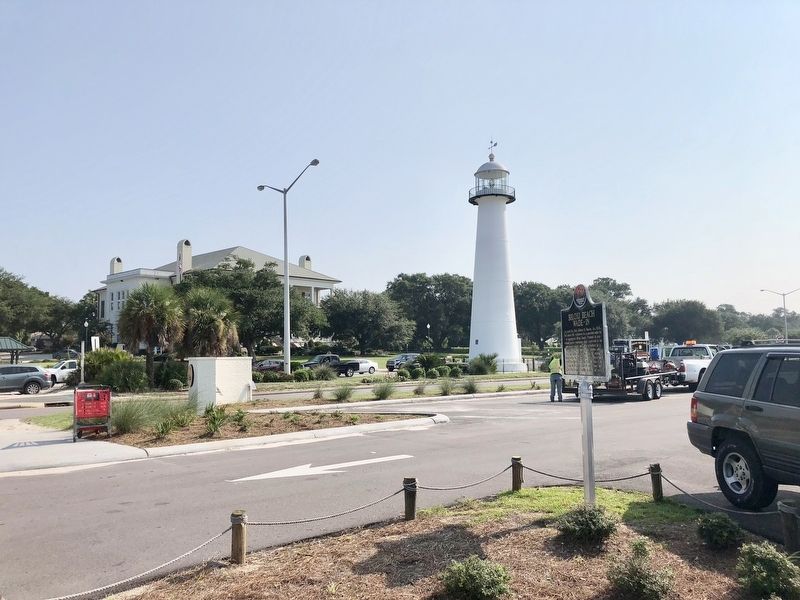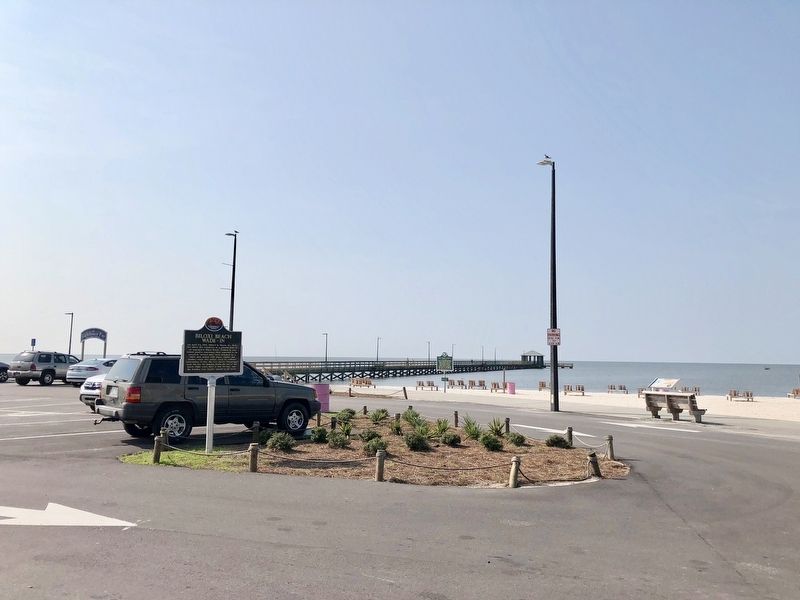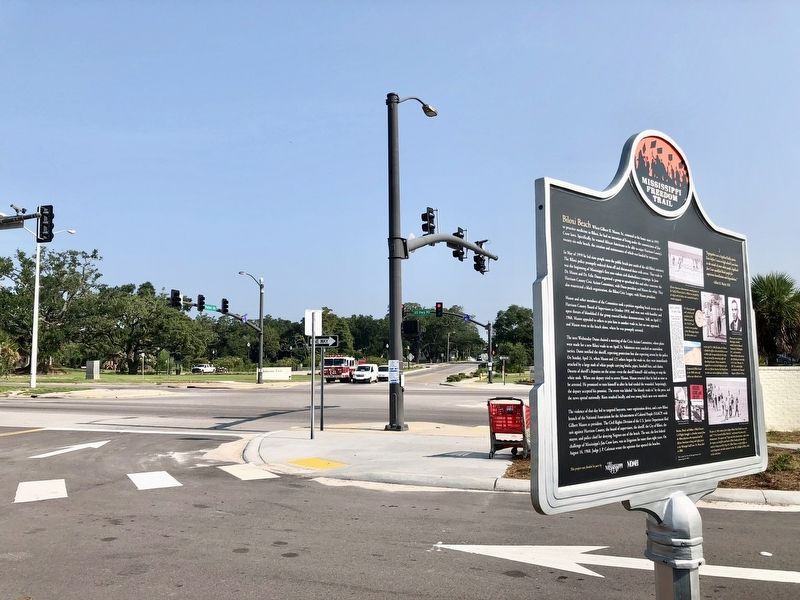Biloxi in Harrison County, Mississippi — The American South (East South Central)
Biloxi Beach Wade-In
— Mississippi Freedom Trail —
Front
On April 24, 1960, Gilbert R. Mason, Sr., M.D., led about 125 volunteers in a peaceful wade-in on segregated Biloxi Beach. Trained in non-violent passive resistance, they expected to be arrested. Instead they were attacked by a white mob armed with pipes, chains, and lumber, while city police stood by without intervening. In May the U.S. Justice Department sued the city for denying blacks the use of the beach. Eight years later it won its case, and the beaches were legally opened to all races.
Reverse
Biloxi Beach When Gilbert R. Mason, Sr., returned to his home state in 1955 to practice medicine in Biloxi, he had no intention of living under the constrictions of Jim Crow laws. Specifically, he wanted African Americans to be able to enjoy Harrison County's twenty-six-mile beach, the creation and maintenance of which was funded by taxpayers.
In May of 1959 he led nine people onto the public beach just south of the old Biloxi cemetery. The Biloxi police promptly ordered them off and threatened them with arrest. That wade-in was the beginning of Mississippi's first non-violent civil disobedience campaign. In June Dr. Mason and Dr. Felix Dunn organized a group to spearhead this and other concerns: the Harrison County Civic Action Committee, with Dunn president and Mason the whip. They also resurrected a black organization, the Biloxi Civic League, with Mason president.
Mason and other members of the Committee took a petition regarding beach access to the Harrison County Board of Supervisors in October 1959, and were met with hostility and open threats of bloodshed if the group enacted further demonstrations. Still, on April 17, 1960, Mason appealed to others to join him in another wade-in, but no one appeared, and Mason went to the beach alone, where he was promptly arrested.
The next Wednesday Dunn chaired a meeting of the Civic Action Committee, where plans were made for a new Biloxi wade-in on April 24. Volunteers were coached on nonviolent tactics. Dunn notified the sheriff, expecting protection but also expecting arrests by the police. On Sunday, April 24, when Mason and 125 others began the wade-in, they were immediately attacked by a large mob of white people carrying bricks, pipes, baseball bats, and chains. Dozens of sheriff's deputies on the scene-even the sheriff himself-did nothing to stop the white mob. When one deputy tried to arrest Mason, Mason retorted that he had no time to be arrested. He promised to turn himself in after he had tended the wounded. Surprisingly the deputy accepted his promise. The event was labeled "the bloody wade-in" by the press, and the news spread nationally. Riots resulted locally, and two young black men were murdered.
The violence of that day led to targeted boycotts, voter registration drives, and a new Biloxi branch of the National Association for the Advancement of Colored People (NAACP) with Gilbert Mason as president. The Civil Rights Division of the U.S. Justice Department filed suit against Harrison County, the board of supervisors, the sheriff, the City of Biloxi, the mayor, and police chief for denying Negroes use of the beach. The suit, the first federal challenge of Mississippi's Jim Crow laws, was in litigation for more than eight years, On August 16, 1968, Judge J. P. Coleman wrote the opinion that opened the beaches.
Erected 2018 by the Mississippi Development Authority Tourism Division. (Marker Number 29.)
Topics and series. This historical marker is listed in these topic lists: African Americans • Civil Rights • Waterways & Vessels. In addition, it is included in the Mississippi Freedom Trail series list. A significant historical date for this entry is April 24, 1960.
Location. 30° 23.65′ N, 88° 54.098′ W. Marker is in Biloxi, Mississippi, in Harrison County. Marker is at the intersection of Beach Boulevard (U.S. 90) and Porter Avenue, on the right when traveling east on Beach Boulevard. Touch for map. Marker is at or near this postal address: 1050 Beach Boulevard, Biloxi MS 39530, United States of America. Touch for directions.
Other nearby markers. At least 8 other markers are within walking distance of this marker. The Landing of Pierre LeMoyne D'Iberville (a few steps from this marker); Design for Future Beach Wade-In Memorial (a few steps from this marker); Civil Rights Wade-Ins (within shouting distance of this marker); Biloxi Lighthouse (within shouting distance of this marker); a different marker also named Biloxi Lighthouse (within shouting distance of this marker); a different marker also named The Biloxi Lighthouse (within shouting distance of this marker); Sea Turtles of the Mississippi Sound (within shouting distance of this marker); Astronaut Fred Haise (within shouting distance of this marker). Touch for a list and map of all markers in Biloxi.
Also see . . .
1. Wikipedia article on the Biloxi Wade-Ins. (Submitted on August 24, 2018, by Mark Hilton of Montgomery, Alabama.)
2. Remembering Beaches as Battlegrounds for Civil Rights. Includes photos of wade-in and Gilbert Mason. (Submitted on August 24, 2018, by Mark Hilton of Montgomery, Alabama.)
Credits. This page was last revised on August 24, 2018. It was originally submitted on August 24, 2018, by Mark Hilton of Montgomery, Alabama. This page has been viewed 358 times since then and 26 times this year. Photos: 1, 2, 3, 4, 5, 6. submitted on August 24, 2018, by Mark Hilton of Montgomery, Alabama.
